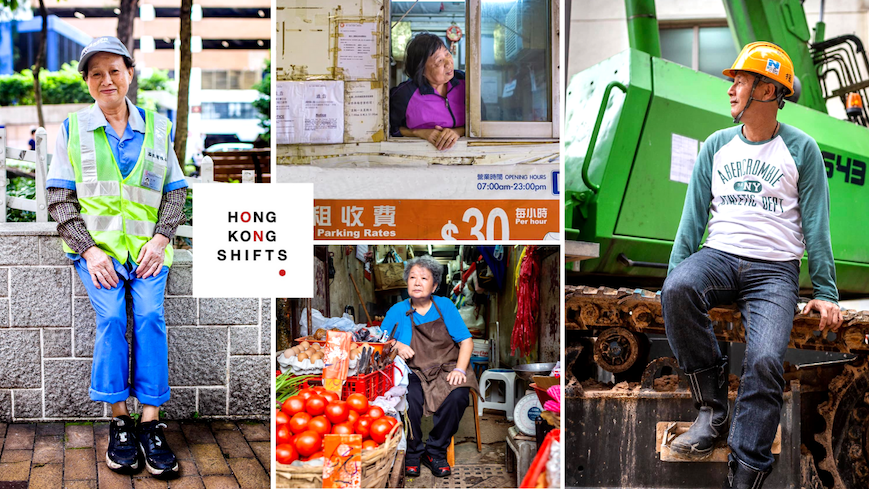In the shadows of towering skyscrapers and high-rise apartments are a population who may not be the face of Asia’s financial capital, but whose stories and contributions as the city’s working class are the reason for the well-oiled machine—and rich tapestry—that is Hong Kong.
One portrait at a time, photojournalism project Hong Kong Shifts set out to chronicle the community in July 2019, interviewing street cleaners, food vendors and other shift workers. Co-founders Cynthia Cheng and Maxime Vanhollebeke publish the photos and stories on Facebook and Instagram, encouraging followers to get to know those whose hard work are too often taken for granted.
For many who are featured, the nature of their jobs as frontline workers accords them visibility, but not necessarily a voice or an outlet to share their narratives through.
Others, like a herbal tea vendor and a fountain pen repairman, are veterans of local sunset industries that have withstood waves of gentrification.
Coconuts spoke with Cynthia Cheng and Maxime Vanhollebeke, the two founders of Hong Kong Shifts, about their motivations behind the project and the message they aim to send to the wider community.
How do people respond when you ask to interview them?
Cynthia: We get all sorts of mixed reactions (when we ask to chat). because we appreciate that the people we want to interview are actually working so they’re on their jobs, on their shifts, and they’re often on the streets as well, so it’s not like we’re sat down at a coffee shop. We do get rejections of course, people say they’re too busy or have no time. But on the other hand, there are some who are immediately very happy to speak. We explain a little bit about our project, [and they say] “Okay sure, let’s chat, you can take my photos.”
How do you approach them?
Maxime: The process is very informal. This project is really about inviting ourselves and the people around us and our communities to [engage in more] dialogue, make connections and be more aware of what’s around us.
Cynthia: Often they’ll say, “Why interview me, interview some other guy, I’m just here cleaning the streets.” But through this project, what we’re trying to express is that everyone has something interesting to say and that’s completely been proven with all of the interviews we’ve done.
What do you hope people can take away from your project?
Maxime: It hasn’t occurred once that we met someone and thought, “Oh, this is too boring.” It really reinforces the key message, which is that everyone has something interesting to say and to share, and we should be more open as members of our communities to seek out these stories.
What is one of the more memorable interviews that Hong Kong Shifts has done?
Cynthia: We were in Sham Shui Po just wandering around the streets, and we came across this old lady in her late 70s or early 80s. She was there collecting cardboard. We approached her and we were pretty much sure she would say no, no, don’t speak to me, which would be understandable. But we were very lucky that eventually, she started talking to us and sharing. She works 16 hours days, sleeps for several hours, makes very little money for all the hard work that she does. That story was quite a heavy one, but it showed her strength and her resilience.
And Hong Kong Shifts managed to get together a small donation for her after sharing her story on social media, right?
Maxime: It was a story that touched quite a large number of people. A lot of people reached out via private message or on social media asking how they can help. We contacted a number of NGOs to see what we could do to help her and other cardboard grannies. Then, we did a supermarket voucher collection for her. It was not much and we are not a charity, and this was not going to change her life in a major way. But when we came back to her, “Here are the supermarket vouchers, here are the messages from the people,” more than the vouchers, it’s the fact that somebody came back. It’s something that she appreciated.
We know the project has collaborated with NGOs like ImpactHK and Habitat for Humanity. What’s next for Hong Kong Shifts?
Maxime: Now that we have a reasonable number of people following the project and who are quite engaged, we want to use the platform to also promote organizations that are on the ground trying to make a concrete impact to address some of the social inclusion diversity issues that we’re highlighting.
Quite early on, we realized that we wanted to work with NGOs and social enterprises. So on a regular basis, we publish a story of one of their shift workers as a way of shedding a light on what the NGO is doing. A lot of NGOs in Hong Kong are amazing at what they are doing, but some have limited resources or manpower to communicate their story. If our project can help, we would love to do it.
To check out Hong Kong Shift’s stories, follow them on Facebook and Instagram.
www.hongkongshifts.com


